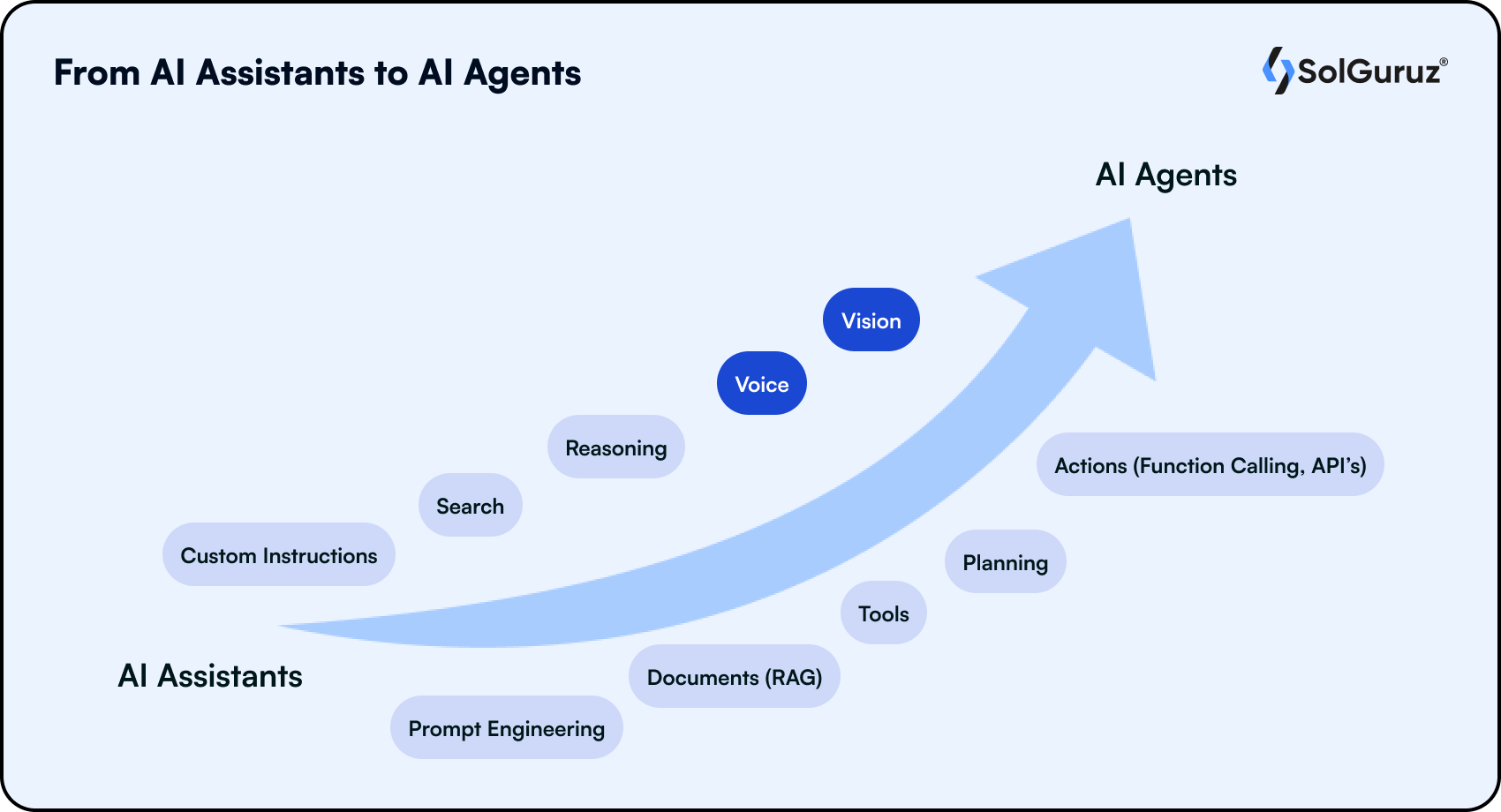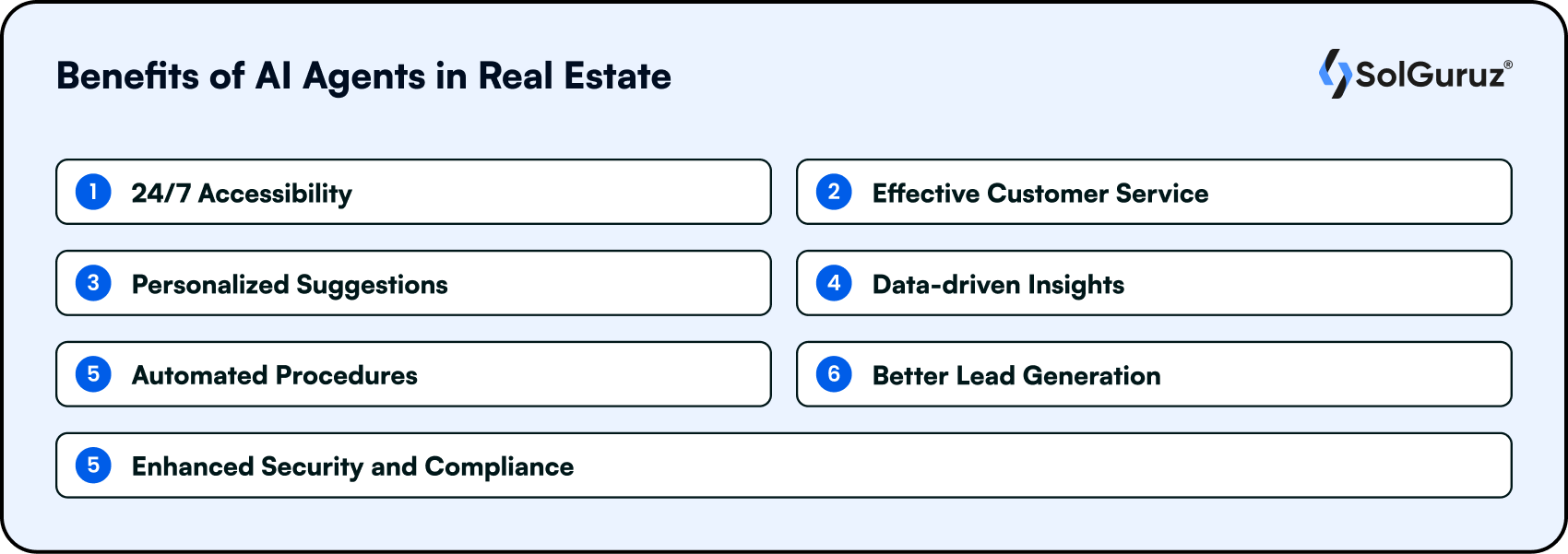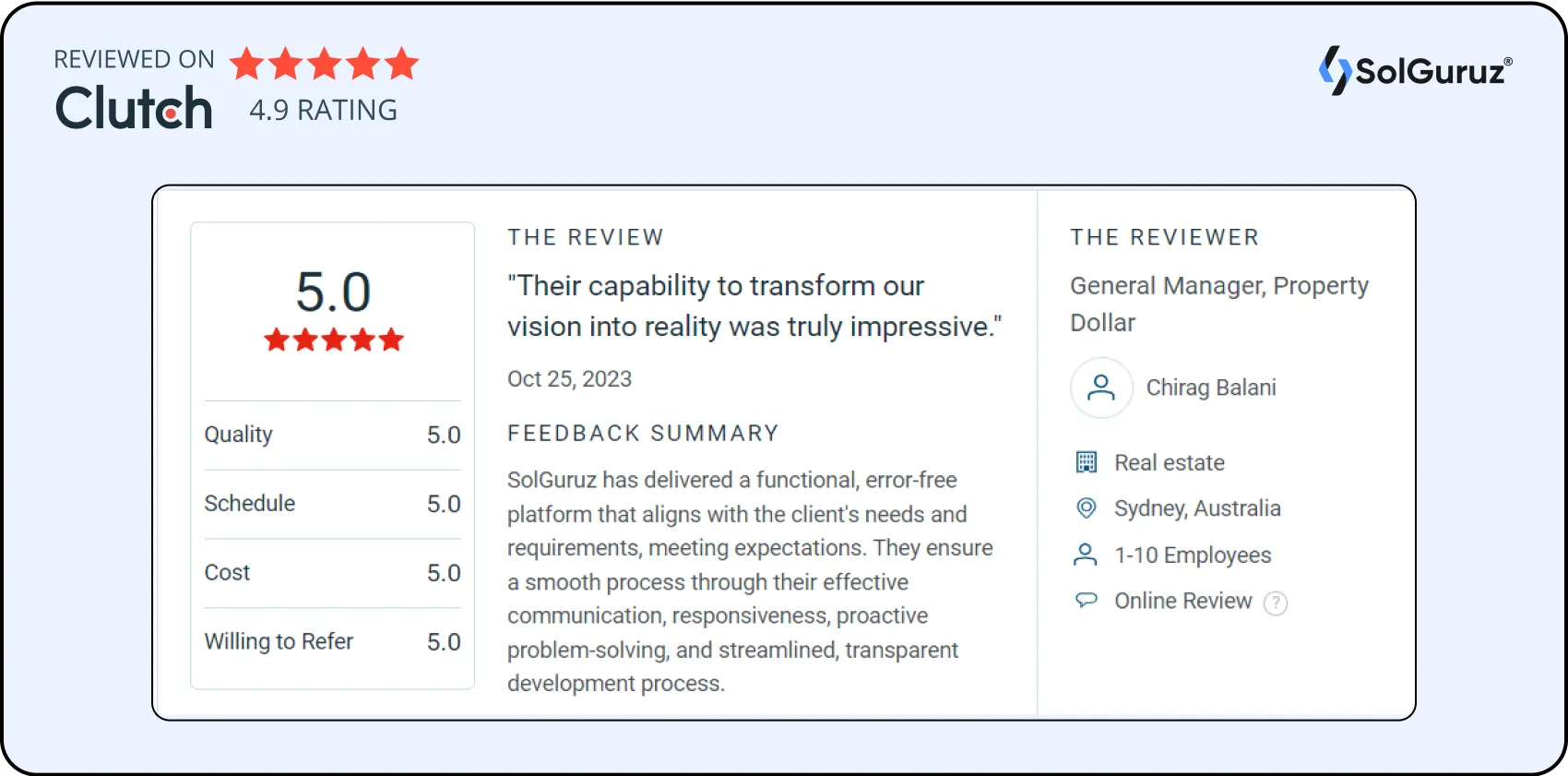Engineering Quality Solutions
AI agents in real estate are shaping the real estate business. Here is a step-by-step guide to integrating AI agents in real estate apps. Take an informed decision and multiply your real estate growth with AI agents.
By Lokesh Dudhat
Last updated on: November 28, 2024

Customers today are facing the challenge of a lack of properties and increased rates of home loans. Whereas real estate business owners face the challenges of property listing. AI has drastically changed property listings. Leading the AI transformation in real estate are real estate apps like Zillow and RedFin using AI algorithms, real estate chatbots, and AI agents to list the property, property evaluation and predict future market trends. AI agents in real estate are redefining the customer experience along with increasing productivity and efficiency.
The secret to improving an AI agent’s efficiency over time is to learn from AI interactions. Real estate businesses can adjust to AI capabilities to match changing workflow requirements. The use of generative AI tools has produced impressive results, such as a 14% hourly increase in issue resolution rates, highlighting the importance of continuous improvement in agent performance optimization.
The blog discusses how AI agents are redefining the real estate landscape and steps to integrate an AI agent into your real estate business.

From giving orders to AI now the time is quickly spinning around to AI making decisions. AI agents are all about letting AI work autonomously, figuring out solutions, and helping them. Rather following orders to correct solutions.
It is like asking Jarvis to schedule a romantic date for Tony Stark. This will need the AI to plan the date, use tools to make the reservations, store information in the memory, and take action. Looks like Jarvis can be a part-time love guru while handling different tasks like finding a new element in the periodic table. (I know references are thoroughly from Iron Man. Recommended watch – Iron Man)
Jarvis was a fictional character in 2008 when the movie was released but seldom we knew that this is a possible future soon in 2024.
AI agents were limited to chatting and giving real-time support to you. The most common use has been of chatbots in real estate. But AI agents are more than that. Let us look into them deeply.
AI agents are a breakthrough in AI automation; they might be chatbots or autonomous systems. These agents can learn, make decisions, and automate difficult activities because they are driven by sophisticated algorithms. This translates to more intelligent property management, tailored customer interactions, and effective back-office operations in the real estate industry.
Adopting AI agents offers numerous advantages that improve workflow success and productivity. In real estate, AI agents work on assisting real estate professionals and clients with automating numerous tasks. Scheduling calls, managing listings, or creating personalized recommendations are some of the tasks that AI agents in real estate can easily fulfill.

The use of generative AI in the real estate sector has altered the image of the industry. People now use real estate to search for properties or business owners post their properties. AI agents in real estate provide a number of important advantages to enhance the overall customer experience and operational efficiency. Here listed are a few benefits of AI agents in real estate:
Regardless of time zones or business hours, AI assistants are always reachable and may respond to questions right away. This increases client satisfaction and engagement by guaranteeing that prospective tenants or buyers may obtain information whenever they need it.
AI agents are able to process a lot of questions at once without making mistakes or delays. They free up human agents to work on more difficult duties by offering prompt responses to frequently asked questions concerning availability, cost, and specifics of the property.
AI agents can provide individualized property recommendations by analyzing user preferences and behavior using machine learning algorithms. The likelihood of finding tenants or buyers with homes that fit their particular requirements is increased by this specialized approach.
AI systems are capable of processing enormous volumes of data to offer insightful analysis of real estate pricing dynamics, market trends, and investment prospects.
AI agents make administrative duties like reminding people to take property tours, setting up appointments, and organizing paperwork easier. Real estate agents work less because of this automation, which also improves operational effectiveness.
Real estate professionals may optimize their strategy and make well-informed judgments with the aid of this data-driven method. Real estate apps like home rental apps or property listing websites are also a good way to look for properties and reduce human intervention. These apps integrate AI chatbots for real estate to solve customer queries.
AI agents can recognize and qualify leads according to parameters like purchasing intent, budget, and preferred location. Real estate agents can increase sales efficiency by concentrating their efforts on prospects that have a higher likelihood of converting by giving priority to high-quality leads.
By securely managing sensitive data, AI agents may guarantee adherence to legal requirements and data protection statutes. In addition to lowering the possibility of human error, this increases client confidence in the real estate transaction process.

The use of generative AI in real estate opens new doors of opportunities as well as new challenges to overcome. There are various challenges in the real estate industry, but integrating AI agents in real estate has different sorts of challenges. Here is the list of challenges that can be encountered:
AI relies on data. Providing correct and flawless, accurate data for AI to process the information and give the results demands clean data. Data sanitization includes making the real estate data error-free, accurate, and AI-compatible so it can be easily processed by the AI agents. It is a difficult and tedious task to sit and sanitize the data.
AI incurs high costs. Integrating AI agents in the real estate app can attract more money than your budgeting plans. AI technology is expensive and it increases the overall cost of the app development.
Personal information that is involved in real estate transactions may be seen by some as extremely secret. Because of this, safeguarding such data is still crucial in terms of security issues. However, as these procedures demand significant resources, compliance with laws like the CCPA and GDPR frequently becomes difficult.
Biased information can directly impact property valuations. AI has a limitation of biases and hence the output generated by the AI Agents will be very likely biased. This impacts not only the property valuations but also the property recommendations, sites, and other things.

The basic components of any LLM agent –
While working on AI agents in real estate they have different elements. Here they are divided into three components-
Read in detail how Generative AI is transforming the real estate business
The step-by-step phase guides you through the different stages of integrating AI agents into your real estate business. Real estate chatbots are different than AI agents in real estate, and the implementation steps also differ.
Research is useful for developers and for the client. Knowing the goals and specifics of the real estate business beforehand helps in establishing clear targets. While implementing AI agents in real estate it is essential to be aware of what the competition is in the market. Researching your needs along with your competitors is the key to the successful implementation of AI agents in the real estate business.
AI has superpowers. Yes, it’s true but AI has many limitations as well. Knowing the powers and limitations of AI often makes the integration phase smooth. For instance – You are much familiar with the GPTs and are ready to integrate one into your real estate business. GPT becomes an obvious choice but integrating PaLM2 into your business for your real estate market needs makes more sense. When dealing with the latest real estate market trends PaLM2 is more useful.
Similarly, if you provide custom real estate solutions then Meta’s AI is comparatively of more use to you. Just integrating one model is not enough, an AI agent is one that has the capability of not only following orders but also planning, arranging, and executing them.
To form a sophisticated AI agent it is necessary to club the right tech with the right tools.
Tools for natural language processing (NLP) are necessary for artificial intelligence (AI) agents to comprehend and respond to human language. They let you design systems that organically communicate with and comprehend their users. Consider developing a virtual assistant to streamline customer support for your company by responding to commonly asked queries on platforms like Chatbase or GPT-3.
Tools for Developing Conversation Flow: By structuring discussions, you may make sure that they are meaningful and productive. You can create a chatbot without writing any code using platforms like ManyChat or Chatfuel, which is perfect for automated conversations on social media or websites.
Platforms for Creating Custom AI Models: With these tools, you may develop AI models that are specially tailored to the requirements of your project. For instance, you don’t need to be an expert in data to train models to forecast customer behavior or market trends using services like Google AutoML or Azure Machine Learning. You can get help from platforms that offer generative AI development services in real estate in creating a custom AI model.
Cost Factor: There are free versions and premium versions of every tool. Keeping in mind the cost efficiency is really necessary. As you integrate the premium version it enhances the features of the AI agent in making but will also increase the cost. Keep in mind that all these additions will eventually increase the overall cost.
It is best to connect with an app development company that has proven experience in developing AI-integrated real estate apps.
An AI implementation team for AI agents in real estate comprises –
AI Specialist – This person has extensive knowledge about AI algorithms, coding, and a bit about managing a team. With a knowledgeable leader, the team leads in the correct direction. A deep knowledge of the latest NLP, machine languages, and latest AI trends becomes a desirable requirement for an effective AI specialist.
Data Scientist – Checking the data quality before delivering the data is necessary. Data scientists sanitize the data needed in the implementation of AI agents in real estate.
Real Estate Expert – The above two components of an effective team are important but lack the core domain knowledge i.e. in this case real estate. A real estate expert knows the locality, its pricing, and its pros and cons. Property listings and managing the different properties are basic responsibilities of a real estate expert.
All these components together make an effective AI team for an effective AI real estate agent.
High-quality data is essential. Assemble essential and superior datasets tailored to your real estate industry needs. This could consist of:
Market data: Details on economic indicators, market trends, and property values.
Client data includes information about past transactions, preferences, and queries.
Property Listings: Detailed information about properties, including locations, costs, and descriptions.
Data preprocessing: Make sure the data is clean and in a format that the LLM can comprehend.
Formatting: Standardize text, numbers, and dates; make sure data structures are consistent (JSON or CSV).
Developing the AI Create a modular AI agent by structuring it as a system with discrete modules for various purposes.
Processing user commands and inquiries is known as input.
LLM interaction: To provide answers and insights, and communicate with the qualified LLM.
Output generation: Display the results of the LLM.
After development comes the testing part. An AI agent must be thoroughly tested for functionality and performance before being deployed. The results must then be carefully analyzed to guarantee quality control and deployment readiness.
Verifying that the AI agent carries out its intended tasks as expected is known as functional testing. Functional testing involves a set of specified tasks, ranging from simple commands to complicated processes, that the AI must perform throughout test execution. On the other side, non-functional testing evaluates features including usability, security, and performance. While security testing looks at the system’s ability to fend off threats and secure data, performance testing makes sure the AI reacts quickly and can handle the anticipated load.
Installing the AI agent entails transforming it from a test environment into a real-world setting where it will be used daily. It is crucial to ensure that the strategy is sufficiently comprehensive at this point.
Establish a test environment that is nearly identical to the production environment to guarantee that the AI agent’s functionality is not compromised in an actual setting. Use comprehensive deployment techniques such as canary releases, blue-green deployment, and incremental updates. They assist you in seamlessly integrating the new equipment into the current system, minimizing needless disruptions.
To prevent impacting all of your end users, implement a staged rollout that can be tested on a small user group and then adjusted accordingly.
Data is the currency in which the IT industry transacts.
Securing the data and its privacy while implementing the AI agents becomes of utmost importance to the developers. Developers understand that when data is compromised not just money but also the business reputation is lost.

AI is offering extensive solutions in different categories, real estate is one of them. The different use cases of AI in real estate and other industries help us to understand the future and real-world applications. Some real-world applications of AI agents in real estate –

AI is already into providing futuristic services. More personalization and better convenience.
Hyper-Personalization – You have a visualization of your dream property. But all the properties the agents are showing you are not it. Searching for the property online you like a property.
The moment you enter the place it is everything you visualized. This is your dream property. How?
The app you used to search properties was using AI to learn your choices and preferences. The future is very personalized. Currently, AI is learning and in the future, it is going to evolve into a smarter version.
Automation – AI has undoubtedly brought automatization in the processes reducing the redundant workload on humans. The future is going to see more automatization and less time taken to complete the tasks.
Increased Efficiency – With automation comes increased efficiency. Simple math –
More work done by AI – More Human force to handle complex tasks. Increased efficiency of AI and more time to humans increasing their work focus and eventually efficiency.
Sophisticated Tech – Integration of newer tech and sophisticated tech like AR and VR. With other emerging technologies
At SolGuruz, we believe in engineering quality solutions and leading the industry with examples.
Our expertise in AI-driven solutions can be quite beneficial when integrating AI agents into your real estate company. By leveraging the power of AI agents, we can transform your real estate software into a highly personalized, efficient, and user-focused platform. Learn more about how our Real Estate App Development Company can support your business’s growth through innovative, AI-enhanced solutions. Take a look at the remarkable success story for one of our real estate clients.

Among the things that set us apart from the competition are our excellent project management abilities, professional work of the highest caliber, prompt delivery, and effective communication.
AI is shaping the world to increase productivity, efficiency, and automation. AI Agents in real estate are going to bring these factors to the table in the future. Whether it is virtual tours automated property valuations or the future trends in real estate, AI agents are shaping the real estate business.
AI agents give creative answers to age-old problems, which is a revolutionary change in the real estate sector. Improved client experiences, increased efficiency, and new growth prospects are all promised by their integration. Adopting these AI-driven solutions will be essential to maintaining competitiveness and relevance in the digital era as the industry continues to change.
Real-time property data are gathered and analyzed by the AI agents. They utilize Automated Valuation Models (AVMs), to automate repetitive tasks. These models analyze different data like recent price hikes, location and price evaluation, and other tasks.
For increased accuracy, AI appraisers may compare properties at scale. Recognize the arbitrary characteristics that influence property value. Identify a feature's worth objectively using comparison data. Determine which data entry is flawed. Update in line with market developments.
Real estate machine learning algorithms enable the analysis of social media sentiment, economic factors, and market movements. These elements support the AI agents' trend analysis and behavior prediction.
With tools like predictive analytics, AVMs, and real estate price analysis AI agents are effective. They help investors and potential buyers to make an informed decision, avoid mistakes, and increase the probability of finalizing a higher-return property.
AI helps real estate agents to develop more focused and successful marketing campaigns. In the real estate industry, machine learning's clever algorithms are used to evaluate large datasets and determine the best channels and messaging to use when contacting prospective tenants or purchasers.
Written by
Lokesh is a Co-Founder and Chief Technology Officer at SolGuruz, a senior technical consultant with over 10 years of experience in exploring the horizon of the software development industry. He has worked closely with startups and enterprises, mentoring them in engineering their tech solutions. With a hands-on experience of 10+ years as a developer, he has delivered solutions using a wide range of technologies such as iOS, Android, Angular, Node, RTC, React, MongoDB, PostgreSQL, Python, and many more. At SolGuruz, we believe in delivering a combination of technology and management. Our commitment to quality engineering is unwavering, and we never want to waste your time or ours. So when you work with us, you can rest assured that we will deliver on our promises, no matter what.
Discover how AI can elevate your real estate web and mobile applications with a consultation from our experts.

Strict NDA

Flexible Engagement Models

1 Week Risk Free Trial
Give us a call now!

+1 (646) 703 7626
Sign up for our free newsletter

Don’t Just Dream Big - Let’s Make It Happen!
For over a decade, I’ve been at the forefront of turning bold, ambitious ideas into groundbreaking solutions. As the CEO of SolGuruz, I’ve had the privilege of helping startups and businesses not only tackle their biggest challenges but scale to new heights with products that don’t just compete - they dominate.
Every meeting with me isn’t just a conversation; it’s a launchpad for revolutionary ideas that can catapult into great products/services. Leaders who’ve taken the step to connect with me have walked away with actionable strategies that made their products unforgettable.
👉 Book a free strategy call with me now and experience the difference. This isn’t just advice - it’s the spark you need to ignite your next big breakthrough.
In a world full of ordinary, let’s create the AI-extraordinary.
Your moment is now - don’t let it pass by.
Paresh Mayani
CEO, SolGuruz
paresh@solguruz.us